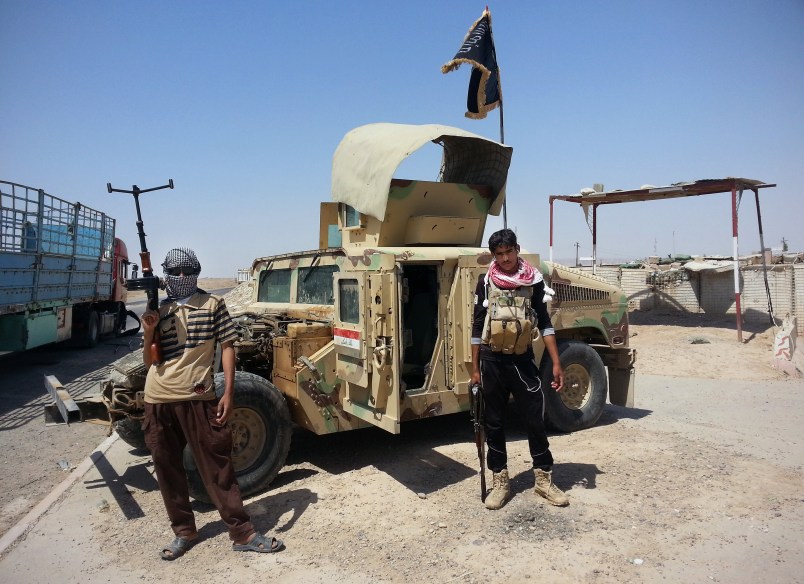BAGHDAD (AP) — Iraqi helicopter gunships struck suspected insurgent positions in Tikrit on Sunday as part of a government offensive to retake the northern city from Sunni militants led by the al-Qaida breakaway Islamic State of Iraq and the Levant, residents and officials said.
The Iraqi military opened its campaign to wrest back Tikrit, the hometown of former dictator Saddam Hussein, on Saturday with a multi-pronged assault spearheaded by ground troops backed by tanks and helicopters.
The predominantly Sunni city, a hotbed of antipathy toward Iraq’s Shiite-led government, is one of two major urban centers that fell to insurgents earlier this month during their lightning offensive across the country’s north and west.
The insurgents appeared to have repelled the military’s initial push for Tikrit, and remained in control of the city on Sunday, but clashes were taking place in the northern neighborhood of Qadissiyah, two residents reached by telephone said.
Muhanad Saif al-Din, who lives in the city center, said he could see smoke rising from Qadissiyah, which borders the University of Tikrit, where troops brought by helicopter established a bridgehead two days ago. He said many of the militants in Tikrit had deployed to the city’s outskirts, apparently to blunt the military attack.
Military spokesman Qassim al-Moussawi told reporters Sunday that the military was in full control of the university and had raised the Iraqi flag over the campus.
A provincial official reached by telephone confirmed that the insurgents retained control of most of Tikrit, and that the fighting was concentrated in Qadissiyah. He also reported clashes northwest of the city around an air base that previously served as a U.S. military facility known as Camp Speicher.
He spoke on condition of anonymity because he was not authorized to brief the media.
The government is eager to make progress in Tikrit after weeks of demoralizing defeats at the hands of the Islamic State and its Sunni allies. The militants’ surge across the vast Sunni-dominated areas that stretch from Baghdad north and west to the Syrian and Jordanian borders has thrown Iraq into its deepest crisis since U.S. troops withdrew in December 2011.
More ominously, the insurgent blitz, which prompted Kurdish forces to assert long-held claims over disputed territory, has raised the prospect of Iraq being cleaved in three along sectarian and ethnic lines.
For embattled Prime Minister Nouri al-Maliki, success in Tikrit could help restore a degree of faith his ability to stem the militant tide. Al-Maliki, a Shiite who has been widely accused of monopolizing power and alienating Iraq’s Sunni and Kurdish minorities, is under growing pressure to step aside. But he appears set on a third consecutive term as prime minister after his bloc won the most seats in April elections.
The government received a boost in its battle with the militants with the arrival in Baghdad late Saturday of five Sukhoi 25 warplanes purchased secondhand from Russia. The aircraft is designed to provide close air support to ground forces and to destroy mobile targets.
Iraqi air force commander Lt. Gen. Anwar Hama Amin said the military is “in urgent need of this type of aircraft during this difficult time.”
“These jets will enter service within a few days — the coming three or four days — in order to support the units and to fight the terrorist ISIL organization,” he said, referring to the al-Qaida breakaway Islamic State of Iraq and the Levant, which has spearheaded the Sunni militant offensive.
The planes could be deployed in the fight for Tikrit, a predominantly Sunni city of more than 200,000 some 130 kilometers (80 miles) north of Baghdad, where anger toward Iraq’s Shiite-led government runs deep.
The Islamic State, which already controls vast swaths in northern and eastern Syria amid the chaos of that nation’s civil war, aims to erase the borders of the modern Middle East and impose its strict brand of Shariah law.
In Iraq, the group has formed an alliance of sorts with fellow Islamic militants as well as former members of Saddam’s Baath party, with all of them hoping to overthrow al-Maliki’s Shiite-led government.
The militants have tapped into deep-seated discontent among Iraq’s Sunnis, who largely dominated the country until the U.S.-led overthrow of Saddam brought the Shiite majority to power. Since then, Sunnis have complained of discrimination and said they are unfairly targeted by the country’s security forces.
___
Associated Press writer Qassim Abdul-Zahra contributed to this report.
Copyright 2014 The Associated Press. All rights reserved. This material may not be published, broadcast, rewritten or redistributed.






